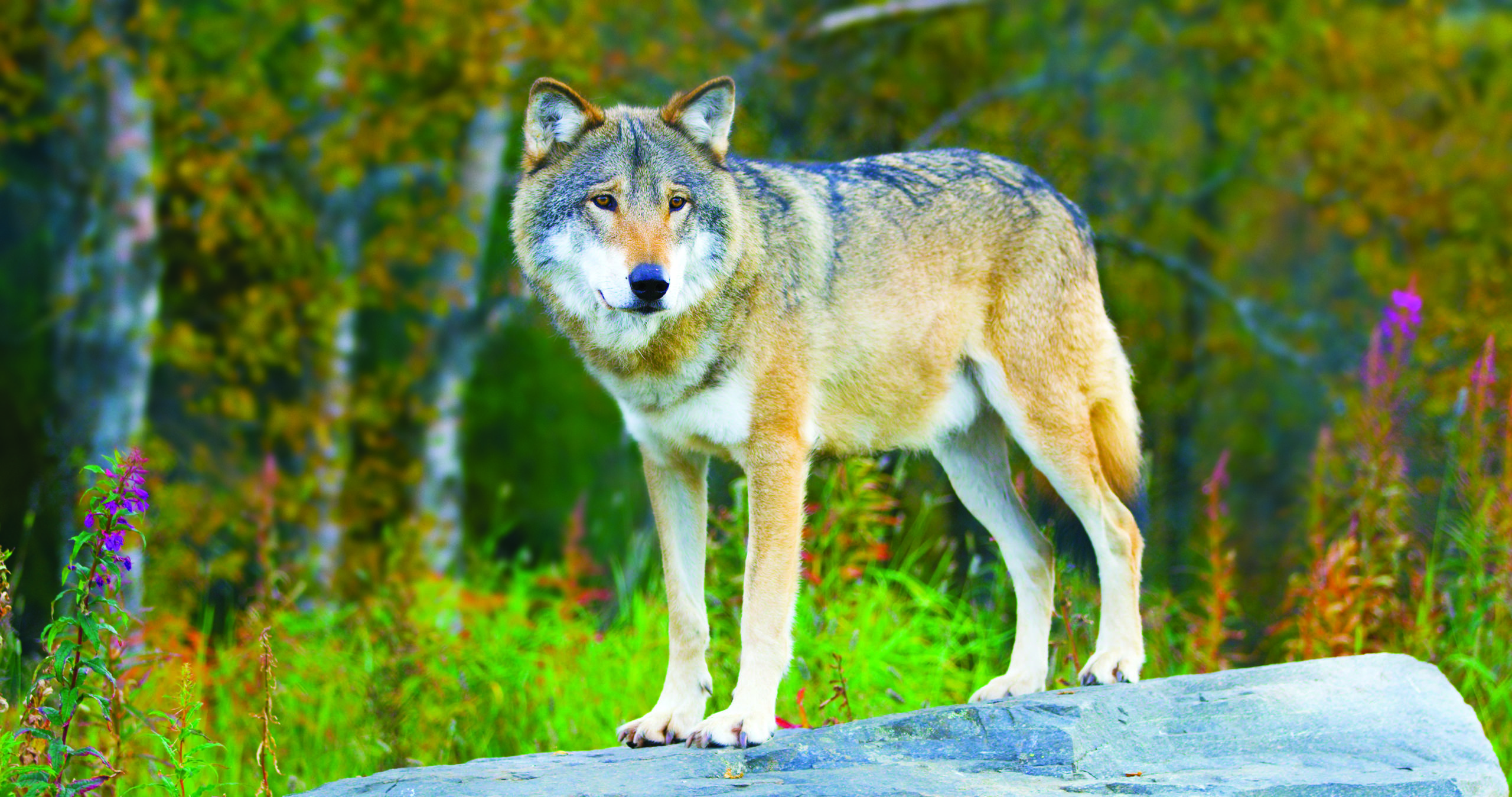
The Trump administration revoked gray wolves’ endangered species status in October of 2020 and, predictably, the decision drew impassioned and mixed responses. Environmental and wildlife advocates were appalled that the administration would remove Endangered Species Act (ESA) protections for an animal that’s still largely extirpated throughout most of its natural range. Others praised the move, celebrating that wolf management had been so successful in some places, that the species could officially be considered “recovered” and their management could be turned over to state and tribal governments.
“After more than 45 years as a listed species, the gray wolf has exceeded all conservation goals for recovery,” Interior Secretary David Bernhardt said at the 2020 press conference announcing the delisting. “Today’s announcement simply reflects the determination that this species is neither a threatened nor endangered species based on the specific factors Congress has laid out in the law.”
Following the delisting, a coalition of Western wildlife advocacy groups, including WildEarth Guardians, filed a lawsuit with a federal court against the U.S. Fish and Wildlife Service. They challenged the decision, saying that it was motivated by politics instead of the best available science, arguing that gray wolves were nowhere near being restored to their full historic range. Their opponents’ arguments were the mirror opposite, claiming that the push to relist wolves was motivated by politics, and that the science said wolf populations had been adequately restored.
On Feb. 10, 2021, the verdict was announced. The federal court had sided with the wolves, and was restoring Environmental Protection Agency protections to the species in almost every state.

That has big implications for how Colorado will manage its own wolf populations. Both as the creatures return naturally, and as the state pursues the gray wolf reintroduction that voters approved in November 2021. In light of several recent wolf conflicts in northern Colorado, the apex predator’s protected status has some ranchers and rural residents feeling helpless.
At the same time, the coalition of wildlife advocates is celebrating the relisting as a monumental victory.
“This is a really big win for us, generally speaking, but also for restoring wolves to Colorado,” Kelly Nokes, the litigating attorney with Western Environmental Law Center says. “Wolves remain functionally extinct from 85% of their historic range … it’s a really rough path to recovery, which is why having federal protections in place is so important.”
WildEarth Guardians contends that the Fish and Wildlife Service failed to consider the historical range of gray wolves—which once covered more than two-thirds of North America—when they pulled the endangered species status in 2020. Instead, the Service based its decision on recovery data from just two core populations in the Great Lakes and Northern Rockies regions, ignoring population data from the vast majority of the species’ natural range.
“It doesn’t make sense to define recovery as having some wolves that are in a limited core population, and we can wipe our hands clean of the recovery mandates from the endangered species act elsewhere where wolves have yet to be restored,” Nokes says. “The job of recovering the species is not quite finished.”
Lindsay Larris is the wildlife program director at WildEarth Guardians. She explains that federal protection is crucial for a species like gray wolves that travel so much and cover such vast distances, often crossing political boundaries that could mean the difference between life and death.
“That’s really important when you’re dealing with states that are often hostile to restoring essential predators to the landscape,” Larris says. “Having something that is in place that really covers the entire country is really important for the recovery.”
Larris notes that the decision to restore ESA protections to gray wolves doesn’t affect the animals’ status in the Northern Rockies regions—in parts of Montana, Wyoming and Idaho. In those areas wolves were delisted by federal legislation under the Obama administration in 2009, and remain delisted despite this recent court decision.
Meaning just outside of Yellowstone (where wolves are protected within National Park boundaries), hunters in Montana and Idaho are allowed to lure the wolves out of the park using bait, strangle them with snares, and shoot them at night on private land. WildEarth Guardians says that in recent months it’s resulted in the death of more than 23 Yellowstone wolves—over 20% of the park’s population.
“Parks like Yellowstone are one of these artificial boundaries,” Larris says. “[Within them, wolves] are protected, as national parks don’t allow hunting. But as soon as they leave that park, they’re subject to being taken by all these horrible methods.”
For wolves residing outside of those Northern Rockies regions, though, the ESA now provides federal oversight for wolf management and protection. It puts an immediate end to wolf hunting, trapping and even “hazing” (techniques used by ranchers to frighten or annoy gray wolves from preying on livestock).
All of which has some environmentalists and wildlife advocates ecstatic, while many ranchers and residents of many rural communities across Colorado watch with trepidation. One Jackson County rancher recently lost two heifers to the new wolf pack that’s taken up residence in northern Colorado. Another rancher lost his dog in a similar attack. And now, without the option to use injurious methods of hazing on these predators, like rubber bullets, some feel as though their hands are tied. However USFWS still permits the use of non-injurious hazing methods like the use of fladry, guard animals, propane cannons, range riders, or noisemakers.
Terry Fankhauser, the former executive vice president of the Colorado Cattleman’s Association, calls the court decision “bad endangered species policy” and “bad wildlife management policy.”
“In my opinion, the court made a bad decision. They made a decision based on interpretive policy related to population segments of the gray wolf as opposed to [considering] if the gray wolf had been recovered adequately in the United States,’” Fankhauser says, echoing the same logic that WildEarth Guardians use to argue in favor of relisting. “You can’t oversimplify management and just make arbitrary statements.”
He points out that both the Obama administration and the Trump administration independently determined that gray wolves had been adequately recovered in the lower 48.
According to Fankhauser, relisting gray wolves as endagred not only makes the issue of dealing with Colorado’s immigrant wolf population more challenging, but further complicates the process of wolf reintroduction that the state voted for in 2021. That reintroduction effort is slated to start in 2023, but now the state management plan is going to be subject to a National Environmental Policy Act (NEPA) review that could drag the process out, Fankhauser says.
“Will Colorado’s administration responsibly put forward a legitimate management plan that involves the required elements to maintain and manage a wolf population, as well as other wildlife and other extraneous issues like livestock production?” Fankhauser asks. “Don’t play political games and just try to get wolves introduced how a select few may want to see them reintroduced. This needs to be a sustainable, meaningful proposal.”
Nokes, with WildEarth Guardians, says that Colorado will have more resources at its disposal to reintroduce gray wolves, with help from the Fish and Wildlife Service, which, she contends, has already proven it can do this successfully.
“Colorado now has the benefit of working cooperatively with the U.S. Fish and Wildlife Service in carrying out this reintroduction,” Nokes says. “That’s the same agency that was responsible for the successful reintroduction [of gray wolves] up in Yellowstone National Park.”
Both sides of this debate seem to agree on at least one point, though: whatever happens with wolves, the decisions need to be guided by science—not politics. (They just don’t see eye-to-eye on what the science says.)
“This is not the first time that the government has tried to remove that [endangered species] protection from [wolves] at all,” Larris says. “And the reason that they keep getting overturned, and [courts] keep ruling in favor of maintaining these protections is because they’re not based on the best science.”
“I disagree 100%,” Fankhauser says. “We have many recovered species that don’t exist on all of their historic range for a variety of reasons. But their populations are stable, they’re secure, they’re recovered—not everywhere—but within the broader sense of the United States and Mexico, they’re recovered. And the gray wolf is one of those.”
At least on paper, the gray wolf was one of those from October 2020 to February 2022. But now, thanks to this federal court ruling, wolves are officially re-endangered outside of the Northern Rockies. How that will play out for our ranchers and rural communities, remains to be seen. But it’s safe to say that after more than 70 years, wolves are once again going to be a part of life in the Centennial State—and Coloradans will adapt.














